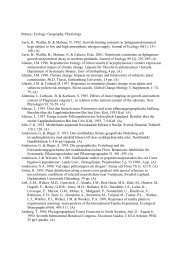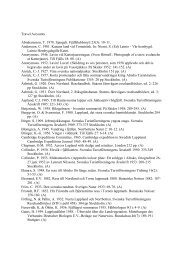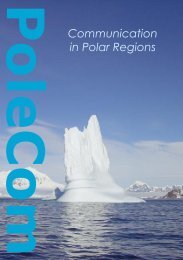Ladda ner årsbok 2008 (6,5 MB) - Polarforskningssekretariatet
Ladda ner årsbok 2008 (6,5 MB) - Polarforskningssekretariatet
Ladda ner årsbok 2008 (6,5 MB) - Polarforskningssekretariatet
Create successful ePaper yourself
Turn your PDF publications into a flip-book with our unique Google optimized e-Paper software.
conditions: temperatures between -3 and<br />
-1˚C, i.e. below freezing, although it should<br />
be noted that seawater in the Arctic freezes<br />
at about -1.8˚C. From around 29 August, the<br />
start of the autumn freeze-up became very<br />
evident and as we left the temperature had<br />
fallen to well below -10˚C and no open water<br />
was present anywhere around us. Our goal<br />
to be on location for the duration of the late<br />
summer melt and the early freeze-up was thus<br />
fulfilled. The return trip through the pack ice<br />
back to Svalbard was easier than expected and<br />
allowed for two more research stations, one<br />
in the MIZ and one in the open ocean, before<br />
arriving again in the fjord off Longyearbyen<br />
early in the morning of 9 September.<br />
New findings<br />
ASCOS was a great success. We monitored<br />
the vertical structure of the atmosphere<br />
and the ocean below the ice, with both in<br />
situ and remote sensing instruments. We<br />
also monitored the structure and phase of<br />
precipitation and clouds as well as the e<strong>ner</strong>gy<br />
fluxes at the surface. Furthermore we were<br />
able to conduct comprehensive sampling of<br />
chemical and physical properties of aerosols<br />
in a specially built laboratory on Oden’s fourth<br />
deck; atmospheric trace gases were also<br />
sampled here. Excitingly, micro-gel precursors<br />
to aerosols were abundant both in the so-called<br />
Undersökning av arktiska sommarmoln, ASCoS<br />
−10 −8 −6 −4 −2<br />
Longitude (°)<br />
Greenland<br />
Forskningsprojektet Arctic Summer Cloud ocean Study (ASCoS) genomfördes under 40<br />
dagar i augusti och tidiga september ombord på isbrytaren oden i centrala Arktis, med syfte<br />
att förbättra förståelsen för hur moln bildas där. Expeditionen startade i Longyearbyen på<br />
Svalbard den 1 augusti och återvände dit den 9 september. Den centrala delen av expeditionen,<br />
som blev en stor framgång, bestod av en tre veckor lång isdrift, då oden förankades<br />
vid och drev med ett 3 x 6 km stort isflak. Mätningar från ca 400 meter ned i havet och upp<br />
genom hela troposfären (de första 8–12 km av atmosfären där moln förekommer) genomfördes<br />
både från oden, isen och från helikopter.<br />
Syftet med ASCoS är att tillhandahålla data som gör det möjligt att bättre modellera moln<br />
i klimatmodeller för Arktis. Dessa moln är av största vikt för e<strong>ner</strong>gibalansen vid ytan och<br />
därmed för smältning och frysning av havsisen. Vi har funnit att de små luftburna partiklar<br />
som varje droppe eller iskristall måste bildas på under sommaren oftast kommer från<br />
biologiska processer i det öppna vattnet mellan de smältande isflaken. För att förstå hur<br />
detta går till, och vilka konsekvenser som ett ändrat klimat kan ha på dessa processer, är<br />
ASCoS med nödvändighet tvärvetenskapligt, och samlar experter inom marin biologi, marin<br />
kemi, oceanografi, atmosfärkemi, aerosolfysik och meteorologi.<br />
Latitude (°)<br />
87.5<br />
87.4<br />
87.3<br />
87.2<br />
87.1<br />
Ice drift 13 August − 2 September<br />
End<br />
Oden´s track for ASCOS <strong>2008</strong><br />
Start<br />
ocean micro-layer, the uppermost ocean surface<br />
water, as well as in the fog water. The<br />
bubbles that bring these from the water into<br />
the air were also abundant. We brought back<br />
large amounts of unique data on such aspects<br />
as multi-phase clouds and related aerosol<br />
properties, and links between aerosols and<br />
the marine biology that will keep us busy<br />
for years.<br />
Svalbard<br />
Figure 4<br />
Track of ASCoS, the insert showing<br />
the ice drift.<br />
åRSBoK YEARBooK <strong>2008</strong><br />
53








